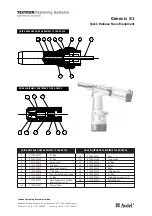
• Damaged hoses can bust
and cause severe injuries or hearing loss.
• Brackets get lose and be projected causing severe
injuries or property damage.
• Tools to start unexpectedly may cause severe
injuries .
• Poorly maintained tools and accessories may
cause severe injuries.
• Damaged or banged tools may cause severe
injuries.
5
Risk Control
when Using Pneumatic Tools
• Compressed air used with pneumatic
tools may be dangerous. Objects like vices, burr, splinters,
dust and other residues can get shot out at great speed
driven by the airflow and enter into your eyes or hit your
head. Airflow by itself can cause damage on soft tissues in
eyes, ears, etc.
• Tool’s accessories can loosen or break
and sent particles towards the operator or other people in
the work area.
Injury Risk to Head and Eyes
• When operating pneumatic equipment wear
protecting eyeglasses complying with ANSI Z87.1
Standard. As an additional protection wear a mask.
• Never aim the airflow to people or animals.
• Disconnect the air hose from the tool when not in use.
• Never leave the tool unattended when connected to the
air inlet.
• Before using the tool verify all the parts and accessories
are securely fastened.
Prevent injury to head and eyes
Risk of Injury
Preventing Injuries
• Inadequate
handling of pressure in pneumatic
equipment may cause an explosion
and severe injury, as well as, using any
gas different from compressed air
causes explosions.
Risk of explosion
• Before using the tool double-check that the compressed air supply is regulated to
the tool specified pressure and is not over that level.
• Never connect the tool into a pressure supply exceeding 200 PSI, neither oxygen
nor any other bottled gas, combustible or reactive.
• Use clean, dry and regulated compressed air with pressure between 80 PSI and
100 PSI.
Preventing an explosion
• Being exposed to noise generated by
pneumatic tools during long periods of time can
permanently damage hearing and cause hearing loss.
Risk of Hearing Loss
• When operating pneumatic equipment always
wear hearing protection complying with ANSI S3.19
Standard.
Preventing Hearing Loss
CAUTION
WARNING
WARNING
WARNING
WARNING
• Do not abuse the hose or the connectors.
• Keep the hose away from sharp or abrasive surfaces.
• Disconnect the hose when loading the cartridge.
• Never use the hose to carry the tool.
• Never pull the hose for disconnect it.
• Do not expose the hose to heat, oil or solvents.
• Before operating the tool verify the hoses are not damaged.
• Use hoses that support at least, 150 PSI or 150% of the system
maximum pressure, whichever is higher.
• Double check that all the connections and brackets are correctly
installed.
• Never carry the tool holding the trigger.
• Disconnect the tool air hose when not in use.
• Never leave the tool unattended when connected to the air inlet .
• Keep the tools clean. A well-kept and lubricated tool delivers a
better performance and is easier to control.
• Any repairs can only be carried out in a
Authorized Service Center.
• Do not use tools and accessories with damaged or banged parts.
ENGLISH
Summary of Contents for 101896
Page 10: ...10 ENGLISH Notes...
Page 15: ...10 ESPA OL Notas...






































